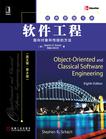软件工程
出版时间:2011-6 出版社:机械工业出版社 作者:(美)Stephen R. Schach 页数:667
Tag标签:无
内容概要
《软件工程面向对象和传统的方法(英文版.第8版)》对软件工程的基础知识(包括面向对象和传统方法)进行了严谨和全面的介绍,是软件工程领域的经典著作。
《软件工程面向对象和传统的方法(英文版.第8版)》共分两大部分:第一部分介绍基本的软件工程理论;第二部分讲述更实用的软件生命周期。作者采用这种独特的、极具可读性的组织方式,帮助学生和广大读者理解软件工程中的一些复杂概念。
最新版第8版对《软件工程面向对象和传统的方法(英文版.第8版)》进了整体更新,新增两章内容,分别概括介绍软件工程的关键知识点和近年涌现的新技术。
作者简介
Stephen R.
Schach 1972年获魏兹曼科学院物理学理科硕士学位,1973年获开普敦大学应用数学博士学位,目前是美国范德比尔特大学计算机科学和计算机工程名誉教授。他的研究兴趣主要集中在软件工程领域,特别是对软件维护与开源软件的实验分析有深入研究。他著有多部软件工程、面向对象系统分析与设计方面的教材。
书籍目录
preface iv
chapter 1 the scope of software engineering
learning objectives
1.1 historical aspects
1.2 economic aspects
1.3 maintenance aspects
1.3.1 classical and modern views of maintenance
1.3.2 the importance of postdelivery maintenance
1.4 requirements, analysis, and design aspects
1.5 team development aspects
1.6 why there is no planning phase
1.7 why there is no testing phase
1.8 why there is no documentation phase
1.9 the object-oriented paradigm
1.10 the object-oriented paradigm in perspective
1.11 terminology
1.12 ethical issues
chapter review
for further reading
key terms
problems
references
part a software engineering concepts
chapter 2 software life-cycle models
learning objectives
2.1 software development in theory
2.2 winburg mini case study
2.3 lessons of the winburg mini case study
2.4 teal tractors mini case study
2.5 iteration and incrementation
2.6 winburg mini case study revisited
2.7 risks and other aspects of iteration and incrementation
2.8 managing iteration and incrementation
2.9 other life-cycle models
2.9.1 code-and-fix life-cycle model
2.9.2 waterfall life-cycle model
2.9.3 rapid-prototyping life-cycle model
2.9.4 open-source life-cycle model
2.9.5 agile processes
2.9.6 synchronize-and-stabilize life-cycle model
2.9.7 spiral life-cycle model
2.10 comparison of life-cycle models
chapter review
for further reading
key terms
problems
references
chapter 3 the software process
chapter 4 teams
chapter 5 the tools of the trade
chapter 6 testing
chapter 7 from modules to objects
chapter 8 reusability and portability
chapter 9 planning and estimating
chapter 10 key material from part a
chapter 11 requirements
chapter 12 classical analysis
chapter 13 object-oriented analysis
chapter 14 design
chapter 15 implementation
chapter 16 postdelivery maintenance
chapter 17 more on uml
chapter 18 emerging technologies
bibliography
appendix
author index
subject index
章节摘录
版权页:插图:A word used on almost every page of this book is software. Software consists of not just code in machine-readable form but also all the documentation that is an intrinsic com- ponent of every project. Software includes the specification document, the design docu- ment, legal and accounting documents of all kinds, the software project management plan, and other management documents as well as all types of manuals. Since the 1970s, the difference between a program and a system has become blurred. In the "good old days;' the distinction was clear. A program was an autonomous piece of code, generally in the form of a deck of punched cards that could be executed. A system was a related collection of programs. A system might consist of programs P, Q, R, and S. Magnetic tape Twas mounted, and then program Pwas run. It caused a deck of data cards to be read in and produced as output tapes T2 and Ta. Tape T2 then was rewound, and pro- gram Q was run, producing tape T4 as output. Program R now merged tapes Ta and T4 into tape Ts; Ts served as input for program S, which printed a series of reports.Compare that situation with a product, running on a machine with a front-end com- munications processor and a back-end database manager, that performs real-time control of a steel mill. The single piece of software contro!ling the steel mill does far more than the old-fashioned system, but in terms of the classic definitions of program and system, this software undoubtedly is a program. To add to the confusion, the term system now is also used to denote the hardware-software combination. For example, the flight control system in an aircraft consists of both the in-flight computers and the software running on them. Depending on who is using the term, the flight control system also may include the controls, such as the joystick, that send commands to the computer and the parts of the aircraft, such as the wing flaps, controlled by the computer. Furthermore, within the context of traditional software development, the term systems analysis refers to the first two phases (requirements and analysis phases) and systems design refers to the third phase (design phase).To minimize confusion, this book uses the term product to denote a nontrivial piece of software. There are two reasons' for this convention. The first is simply to obviate the pro- gram versus system confusion by using a third term. The second reason is more important. This book deals with the process of software production, that is, the way we produce soft- ware, and the end result of a process is termed a product. Finally, the term system is used in its modem sense, that is, the combined hardware and software, or as part of universally accepted phrases, such as operating system and management information system.Two words widely used within the context of software engineering are methodology and paradigm. In the 1970s, the word methodology began to be used in the sense of "a way of developing a software product"; the word actually means the "science of meth- ods."
编辑推荐
《软件工程:面向对象和传统的方法(英文版)(第8版)》是经典原版书库之一。本版新增内容:新增两章内容:第10章总结第一部分涉及的关键知识点,便于学生在做团队项目时参考使用;第18章概括介绍面向方面的技术、模型驱动技术、基于组件的技术、面向服务的技术、社交计算、Web工程、云技术、Web 3.0和模型检测等新技术。•扩展设计模式的相关材料,新增一个小的案例•新增两个理论工具,即分而治之和关注点分离•新增100多道习题,并更新了大量参考文献。
图书封面
图书标签Tags
无
评论、评分、阅读与下载
用户评论 (总计3条)
- 应该是高仿 纸质比我同学从学校买的正版的略差
- 没什么优缺点可说的!
- 这本书是学校要求我们买的教材,比学校的价格优惠,但是优惠力度还不够喔,希望以后亚马逊加大力度搞活动啦
